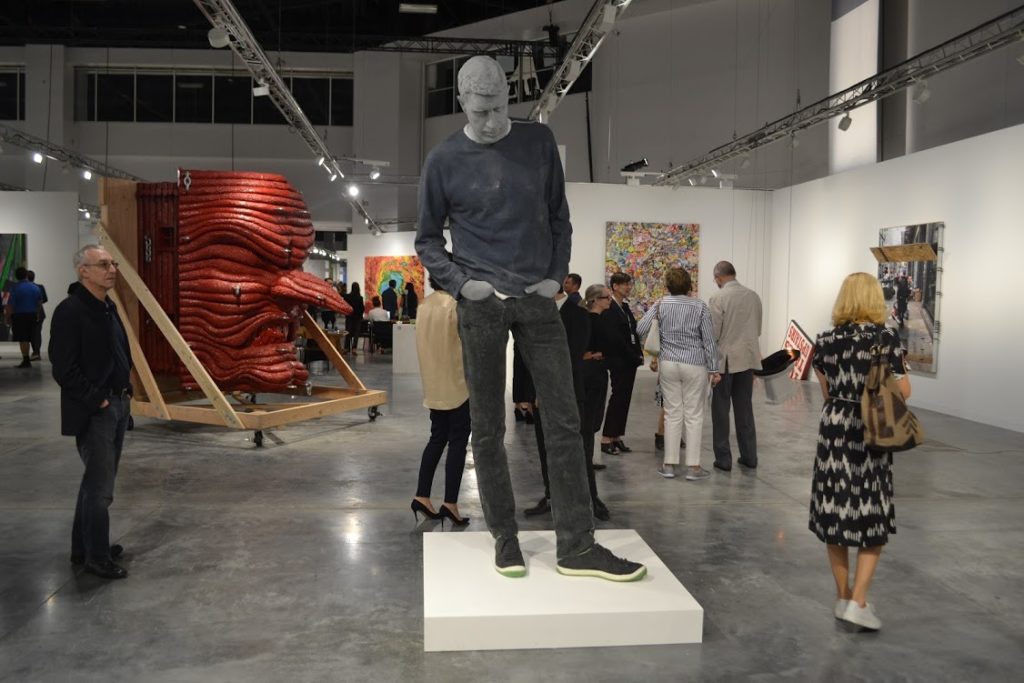A pack that included some of the world’s top art collectors streamed into Art Basel Miami Beach’s First Choice preview this morning, and as the day went on buyers snapped up dozens of seven-figure works from the 268 galleries that have set up in booths at the city’s convention center. Despite construction outside related to ongoing renovations of the building, and a brief setback that prevented exhibitors from entering for 30 minutes during the pre-fair set-up, dealers said that the fair’s rejiggered landscape for the most part encouraged repeat visits and spurred big sales.
In the openings hours, Hauser & Wirth managed to place Bruce Nauman’s Untitled (Two Wolves, Two Deer), 1989, in an Asian collection to the tune of $9.5 million, a mark just a hair shy of the artist’s auction record of $9.9 million. Hauser also sold Mark Bradford’s new black stone-studded canvas Moon Rocks (2017) for $5 million, while nearby, Gagosian was selling work by Ed Ruscha, Rudolph Stingel, and Cecily Brown for up to $3.5 million, and David Zwirner found buyers for Neo Rauch’s Tank for $1.2 million and Yayoi Kusama’s Standing at the Flower Bed (2013) for $1 million.
“It’s been slow but steady,” Zwirner said at his booth, standing in front of two Jeff Koons gazing ball works that apparently had yet to sell.
“This new floor plan confuses people a bit, but once they find their favorite galleries, they’re buying,” he went on. “Normally it’s all front loaded, but people have been coming back two or three times and buying, so I’ll take that.”
The new floor plan is indeed a change from years past, if a subtle one. With the renovation going on, Art Basel was able to give the space a makeover and make some moves—which risked alienating longtime supporters who have committed routes to memory, but also allowed for positive little tweaks. There is 10 percent more exhibition space, giving the booths more of an airy feel, and wider aisles allowed for more room to duck in and out of different galleries with ease. And new central lounges, complete with large hanging greenery, created power-clusters, with Zwirner, Gagosian, Lévy Gorvy, Pace, and Gladstone Gallery all bordering the same cafe area.
“The new layout is definitely working out,” said Pace’s president, Marc Glimcher, standing in his booth.
It was early afternoon, but the gallery had already sold a Willem de Kooning work on paper for $450,000 and a Sol LeWitt work on paper for $250,000, along with what Glimcher said was about half the booth.
And there was serious interest in Pace’s high-concept offerings: in the booth, a wide white plank acted as the base for a miniature sculpture park, where to-scale models of massive outdoor works sat. As I talked to Glimcher, the dealer Almine Ruiz-Picasso was inquiring about a dollhouse-size work by Jean Dubuffet, which in reality is 28 feet by 48 feet, and on sale for $12 million.
“All this is complicated work, and it’s not for the quick sale, but you start having conversations,” Glimcher said.
The sales all happened despite a speed bump that threatened to derail the traditional 11 a.m. rush. Exhibitors are let into the convention center early to make last-minute adjustments to their booth, arrange catalogues, and have a game-day pep talk with staff. But at 10:15 this morning, the fire marshal mysteriously issued a moratorium on all entrances and exits, forcing any other arriving dealers to wait outside, regardless of status. After a half-hour in the heat, just minutes before the collectors piled in at 11, the dealers were allowed to enter.
“Larry was stuck outside, Zwirner was stuck outside, you had to get here really early!” Glimcher said.
Larry Gagosian could not be found to personally verify that he was part of the snafu, but Zwirner confirmed that he had to wait among his fellow gallerists.
“I was stuck outside, and then I got in, but I was pretty annoyed,” Zwirner said. “You have that hour to look around the fair in peace and that was stolen from me.”
The trouble continued somewhat when the fair actually opened, as some clients got stuck in lines due to changes in the entrance system amid renovations.
“This is all about how clients are feeling, and there were some problems with people getting in,” said Brett Gorvy. “But that’s basically just a teething issue.”
When stopped at the fair, Art Basel’s director, Marc Spiegler, confirmed that the fire marshal shut down the east entrance for 30 minutes. Without going into details, he said that “they spotted something in the halls” and needed to make sure everything was safe before letting anyone else enter.
He admitted that, for dealers, “it was half an hour, but it was a crucial half an hour.”
And yet sales seem on par with past opening days at Art Basel Miami Beach. Sadie Coles sold one of Urs Fischer’s towering wax statues—which are intended to be melted down, and then refabricated—and this statue was of fellow artist Adam McEwen. The price paid was $750,000. She also sold a painting by Fischer for $850,000. One booth over, Petzel sold a brand-new work by Dana Schutz, Self-Exam, for $275,000, while Lisson sold a green Anish Kapoor work for £600,000, or $802,000. Mnuchin placed a Mark Bradford, Fly in the Buttermilk (2002 ), in a collection for $3 million.
This being Art Basel Miami Beach, celebrities made the occasional appearance—Owen Wilson at the Van de Weghe booth checking out a Keith Haring with Stellan Holm, Leonardo DiCaprio emphatically embracing Mark Bradford, who had shown up in person ahead of a dinner in his honor tonight, thrown by Hauser.
The collectors included Dasha Zhukova, Jorge Pérez, Irma and Norman Braman, and Maurice Marciano, who was spotted at the Gavin Brown’s Enterprise booth seemingly unaware of the woman holding a large bag from Marciano, his family’s fashion brand, standing right by him.
Art Basel Miami Beach is open through Sunday.








